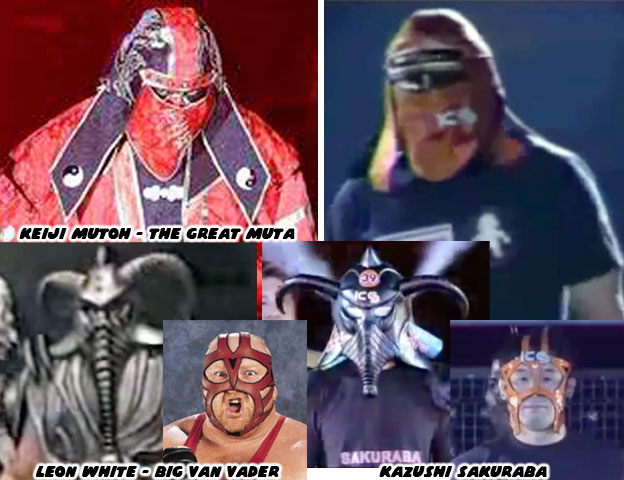
Despite the flash there was substance to the man. Sakuraba seemed to excel at defeating experts at the BJJ style. The people he defeated read like a who's-who of top Gracie students. The list included Paul Herrera, Conan Silveira, Vernon White, Carlos Newton, Vitor Belfort, Ebenezer Fontes Braga, Anthony Macias and Guy Mezger. Eventually his successes had caught the eye of the Gracie family. Determined not to let one person undo the half-century of work that Helio had put into the system they began sending actual family members to fight Sakuraba. Royler was the first and he was defeated using the same move applied to Helio decades earlier, the Kimura. In fact it was the first defeat for an actual family member since that encounter in 1954. The Gracie family was out for blood now. Unfortunately for them Renzo, Ryan and even Royce Gracie were all met with defeat. Before the dust had settled Sakuraba was awarded a belt by the Pride organizers in his trademark orange and was dubbed the "Gracie Hunter" by the press.
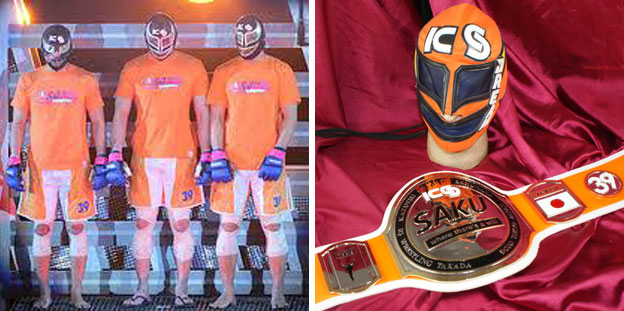
It was a proud few years for the nation. One of their own hometown boys had single-handedly defeated the system that had conquered the MMA universe. Sakuraba had stripped the mystique surrounding Gracie Ju-jitsu. Even when the Gracie family made stipulations before each match Sakuraba agreed to abide by them. He had exposed the flaws of the system and the practitioners. The mystique and air of superiority that the family once enjoyed had been shattered.
Yet it was not the first time a world champion had been humbled by the inevitable. Young "Iron" Mike Tyson had enjoyed an amazing run in his professional boxing career in the early '80s. Destroying most of his opponents in the first few seconds of the fight was impressive but made countless millions of cable subscribers furious. Yet the lack of discipline after the death of his trainer and mentor Constantine "Cus" D'Amato had started Tyson on a downward spiral. He began falling in with the wrong crowd, including promoter Don King, and before too long the mystique of Mike Tyson disappeared with his first defeat at the hands of James "Buster" Douglas. Tyson found himself on a downward spiral of self-destruction. His time spent in jail dulled his legacy and by the time he was given a chance to reclaim the title it was apparent to all that Tyson was no longer an immortal. For a fighter to remain at the top hard work, technique and natural ability were all important assets but the one wildcard was presence. If a fighter appeared to be impossible to defeat, or got into the head of an opponent then they would gain the advantage.
The Gracies and BJJ practitioners had the reputation going for them. The techniques had been proven on the streets, in the bars, in the dojos and on the professional stage. Gracie Ju-jitsu was a serious fighting art, capable of disabling or even killing a person. Yet once there was a crack in the armor, something that could be exploited, then other fighters would no longer believe in the superiority of the BJJ practitioner. They would no longer allow themselves to be intimidated even by actually dangerous fighters. What Sakuraba had done to the system was dull its reputation. He went into each fight prepared and fearless.

A similar thing had happened in 1971 when Joe Frazier knocked down Muhammad Ali. Considered the greatest heavyweight boxer that ever lived few ever stood toe-to-toe with Ali and even less managed to drop the man. Joe Frazier had actually been worked into a frenzy by Ali. The constant ridicule and trash talking had gotten into the mind of Frazier. They had once been friends but Ali raised the stakes when he tried to assert his presence over Frazier. What Frazier saw in the mocking by Ali, being called an "Uncle Tom" and a gorilla to the press was not promotion but betrayal. The heavyweights had said all that could be said about the man. Frazier was the only fighter ever to talk back to Ali in the ring, even when he was getting beat. George Foreman even admitted that he feared Joe Frazier. It was said that when Frazier stepped into the ring against Ali he was prepared to die. What he did was show the world that the great Ali was mortal after all.
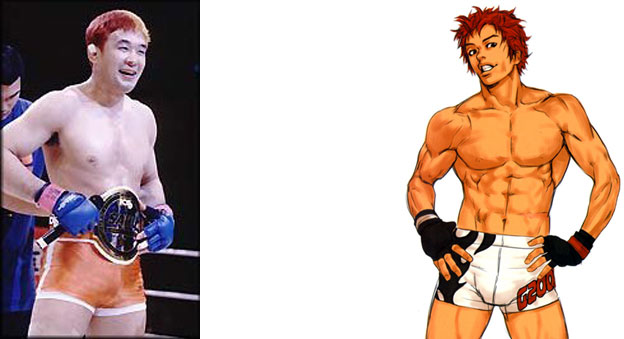
Sakuraba was rewarded for his efforts with more than a belt and the admiration of millions. He also influenced the character design of Tendo Gai for SNK's Buriki-One. The flashy young fighter could never be mistaken for a master of one of the traditional arts. The game did in fact feature karate, sumo, tae kwon do, muay thai and wrestling characters. Each of the fighters wore traditional uniforms save for Tendo who wore the shorts and gloves of a modern MMA superstar. Gai was also influenced by the character Baki from the manga and animé series Baki the Grappler. In the series Baki was a gifted teenager with impossible strength, speed and stamina. He was capable of destroying older, larger fighters. He used creative training techniques, beat up wild animals and did all sorts of amazing things in the graphically violent series. Tendo Gai was only 17-years-old in the game. He was a self taught master of "Total Fighting" which he developed after graduating from middle school. It would make him one of the younger fighting game masters ever developed.

Buriki One featured blocky characters, an odd control scheme and lacked the smooth gameplay that audiences were used to. Few saw the title and many forgot it was even part of SNK canon until they brought back a few of the characters in the King of Fighters series. By then the studio had adapted a few of the actual fighting moves of Sakuraba into something that would work for a game. For example the Gracie fighters would sometimes lay prone on their backs and try to trick fighters into engaging them on the ground. It seemed like an easy target for most but the BJJ fighters excelled in ground grappling and often made opponents submit just moments after taking the battle to the floor. Sakuraba kept a cool head during his fights with them and refused to engage them on the ground. Instead of trying to mount his opponents Sakuraba would kick at their legs and try to do as much damage as he could to them while they laid prone. This would slow them down and weaken their resistance as the rounds went on. By being on their backs they could not generate much force when they kicked back. When Sakuraba saw an opening he would actually take a running leap at his opponents and try to kick them as he came down. After a few attempts at this he would sometimes trick opponents by running at them and hitting them with a baseball slide kick. These attacks would be included in Tendo Gai's move set for the KOF series.
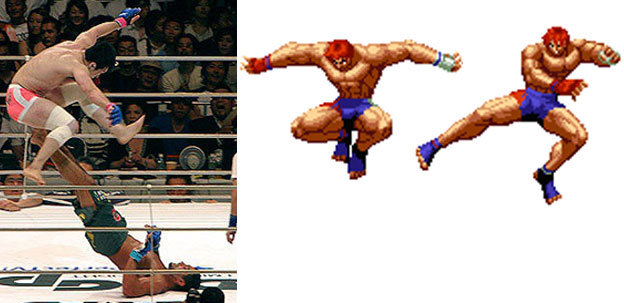
In one Sakuraba's more flamboyant moves he would try to close the distance between the prone grapplers by performing a cartwheel and going after an exposed arm. This move was also given to Gai as the character dashed forward to close the gap between he and his opponent.
By controlling the pace of the encounters Sakuraba managed to throw the BJJ experts off of their game. What was interesting about the development of Tendo Gai was that he was given moves more grounded in reality than those usually reserved for KOF or even Street Fighter characters. He existed in a world where some characters could throw "fireballs" or topple giants with "dragon punches" but it didn't matter. His all-around moves, solid combo system and painful joint locks were just as destructive and much more plausible.
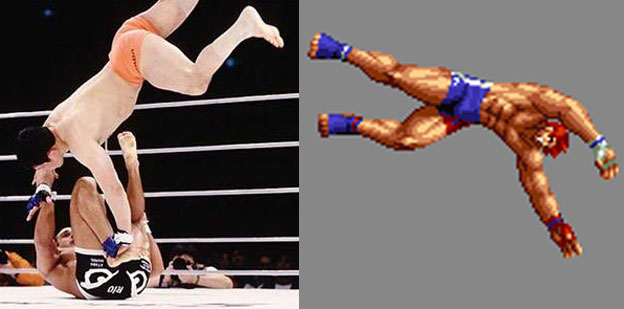
Sadly the era of Sakuraba would close almost as quickly as it came. Another Brazilian would dethrone the man but not with the BJJ techniques. Wanderlei Silva aka the Axe Murderer was an exceptional striker and excelled at muay thai techniques. His barrage of strikes and knees defeated Sakuraba in all three of their encounters. Sakuraba would lose more than he won through a period in the early '00s. Eventually he would end up splitting the difference between wins and losses for the rest of the decade. To many Sakuraba had stayed in the fight game for too long. The next generation would try to make a name for themselves by going after a man past his prime. Royce Gracie got a much anticipated rematch and won the decision. He later tested positive for steroids so the match was declared a no-contest. A Gracie family member would finally manage to defeat the man but under controversial circumstances. Ralek Gracie, the son of Rorion defeated Sakuraba in 2010. The ref stopped the fight and allowed Ralek to pull up his shorts after Sakuraba had applied a submission move. To add insult to injury Ralek was 24 at the time and Sakuraba was 41.
To many the legend of Sakuraba would never die. He had proven himself time and time again against some of the best in the world at their prime. As an old man he could still pull a rabbit out of the hat. His submission of the decade against an up-and-comer Zelg Galesic was the stuff that dreams were made of.
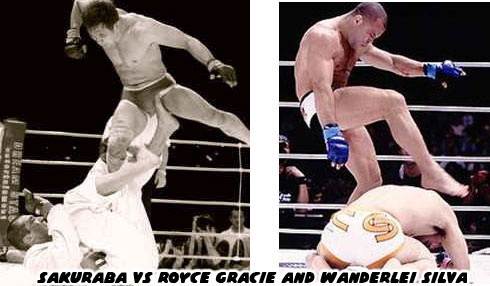
What the fight community wondered aloud was whether Sakuraba was a flash-in-the-pan, a fluke. He was a pro wrestler that knew how to throw bombs. But wrestlers never faired well in most MMA tournaments no matter how well they punched or kicked. What was the community overlooking if anything in the ability of Sakuraba? The next blog will try to unravel the mysteries of wrestling and see it as the fight science it actually is. As always if you enjoyed this blog and would like to sponsor me please visit my Patreon page and consider donating each month, even as little as $1 would help make better blogs and even podcasts!

No comments:
Post a Comment